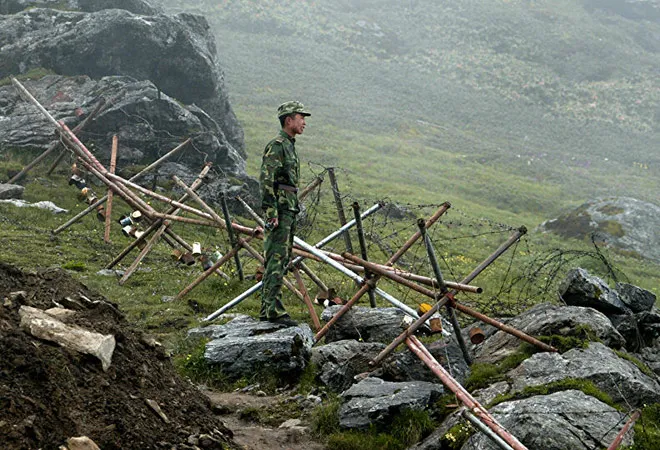The Sino-Indian violent face-off at the disputed border in Ladakh appears to have changed the strategic calculus in the South Asia. Increasingly, countries in the Indian sub-continent are finding it difficult to balance India and China, a tactic adopted by most, weaker nations towards the strategic rivalry between the two giants. The Himalayan kingdom of Bhutan is also facing a test in balancing her southern and northern neighbours.
China has now claimed the Sakteng Wildlife Sanctuary, located in eastern Bhutan, at the Global Environment Facility (GEF), a multilateral, international initiative that works in partnership with the United Nations. During a discussion in June on a project for the sanctuary, China described it as a disputed territory. The claim was at once rejected by Thimpu, which said the Sakteng sanctuary is an integral and sovereign territory of Bhutan and at no point during the boundary discussions between the two nations has it featured as a disputed area.
Behind border aggression
Bhutan-China relations in the past were limited to Bhutan’s feudatory relations with Tibet. China’s occupation of Tibet was a watershed in the relations between the two countries. Thus, Bhutan came to share a 470 km long un-demarcated border with northern neighbour China.
The Himalayas in the north acted as a natural barrier between Bhutan and China. However, there are some pastures, measuring approximately 269 sq.km, which are disputed. The dispute in the west of Bhutan in the Doklam plateau is limited to 269 sq.km. According to Bhutan, there is no boundary dispute in the east.
However, China’s new claim in eastern Bhutan is a result of China making the erstwhile Tibetan Kingdom’s claims its own. Bhutan is bound to Tibet by centuries-old cultural, religious and social contact, which are all in evidence even in Bhutan’s social and political systems. Tibet had traditionally claimed the entire Buddhist regions in the Himalayas viz. Bhutan, Ladakh, Sikkim and India’s North-East as its own.
The claim on the Sakteng sanctuary in the Trashigang district of Bhutan must be seen in this light -- of China continuing the position of Tibet treating Bhutan as a vassal state. Similar claims are made by China for Tawang, that shares a border with Trashigang. Scholars have identified these claims as part of China’s ‘Western Development Strategy’ that aims to facilitate Tibet to regain a central position in the Himalayan system. The Western Development Strategy appears to be behind China’s increasing aggression all along Tibet’s disputed borders in Doklam, Ladakh and Bhutan.
Search for fine balance
Since the 1980s, when the first round of Bhutan-China border talks were held, the two sides have so far held 24 rounds of border talks. The last round was held in 2016 in Beijing. The next round was due in 2017 but that was deferred in the wake of the 72-day India-China standoff at Doklam in the same year. In 2018, Bhutan elected a new party -- the Druk Nyamrup Tshogpa (DNT) -- to form the government.
China throughout this period maintained contact with Bhutan in the hope that Thimphu would consider establishing diplomatic relations with its northern neighbour. Beijing for long has pressurised Bhutan to establish formal diplomatic relations as a pre-requisite for resolving the decades-old border dispute.
China erred in assuming that the rout of the perceptibly India-friendly former incumbent People’s Democratic Party was an indication of the anti-India wave surging in Bhutan. Allaying all fears, the Bhutan-India relations instead strengthened with Indian Prime Minister Narendra Modi visiting Bhutan for the second time.
However, like in the Doklam stand-off, Bhutan has trodden cautiously, not upsetting China, lest it complicate matters for the resolution of its border dispute with China. In the past, it also restrained Tibetan refugees in Bhutan to Thimphu, maintaining throughout a ‘One China’ stand in the United Nations, taking precaution in respecting China’s core interests.
Even if we take the present controversy regarding the Sakteng Sanctuary in Trashigang, Thimphu has guarded China’s strategic interests. Bhutan, from the fear of not being inimical to China’s strategic interests, has till date warded off India’s proposal to build a motorable road from Lumla in the Tawang district in India to Trashigang in eastern Bhutan.
The Lumla-Trashigang road is of strategic importance to India as it provides an alternative route, primarily to the Indian defence forces, to reach Tawang from Assam through Bhutan. In the absence of an alternative route, the Indian defence forces manning the India-China border are using the Sela Pass that is snow-clad in the winter season, making transit through it difficult.
Punishing an Indian ally?
The deterioration in the US-China relations has made it harder for Bhutan to balance China and India. Further to China’s worries was the Bhutan visit of US Deputy Secretary of State John Sullivan in August last year. Sullivan, the highest-ranking American diplomat to visit Bhutan, speaking in Thimphu, stressed the need for protecting and enhancing rule-based order in the Indo-Pacific.
In the recent past, Bhutan’s toing of India’s line in not joining the Belt and Road Initiative and the show of support for Japan’s candidature for a permanent seat in the UN Security Council during former Prime Minister Tshering Tobgay’s visit to Japan in 2018 is perceived by China to be against its strategic interests. Thus, China drawing eastern Bhutan into dispute is also aimed at punishing an Indian ally.
This commentary originally appeared in South Asia Weekly.
The views expressed above belong to the author(s). ORF research and analyses now available on Telegram! Click here to access our curated content — blogs, longforms and interviews.




 PREV
PREV


